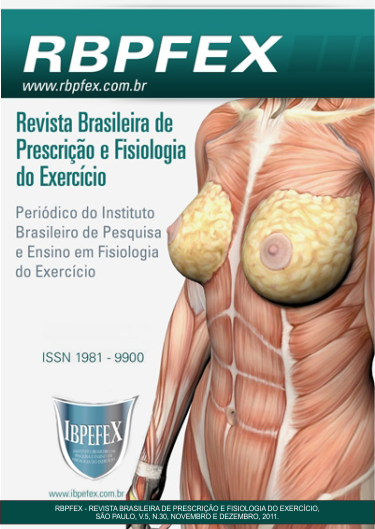Proposal for a practical class of running tests under the perspective of problem-based learning
Abstract
A major challenge for teachers who teach courses in the area of Exercise Physiology is to execute the module on the Bioenergetics. In a short time, the professional needs to address all the dynamics that involve cellular metabolism (restricting here only to factors related to skeletal muscle). There are great difficulties in deepening the theme, because it depends on both the teacher training and curriculum of the institute. The purpose of this study was to present a strategy based on the indication of problems to students, so that the resolution occurs by the process of teaching pre-set by the teacher. As a problem situation, present a strategy study of metabolism using two forms of racing on the track: racing intense 400-meter dash and running test of 12 minutes. The results showed that the organization of a situation by the teacher acts as facilitator for learning -not as a tool for quick solutions to problems.
References
-Antunes Neto, J. M. F.; Vilarta, R. Fadiga muscular e exercício excêntrico: revisão dos eventos moleculares. Lecturas, Educacíon Física y Deportes, Num. 156. 2011a.
-Antunes Neto, J.M.F.; Vilarta, R. Contração muscular excêntrica: processos indutores de microlesão celular e síntese de proteínas miofibrilares. Lecturas, Educacíon Física y Deportes, Num. 15. 2011b.
-Berbel, N.A.N. A problematização e a aprendizagem baseada em problemas: diferentes termos ou diferentes caminhos. Interface-Comunicação, Saúde, Educação. Vol. 02. Num. 02. 1998. p. 1-16.
-Bonen, A. Lactate transporters (MCT proteins) in heart and skeletal muscles. Medicine and Science in Sports and Exercise, Num. 32. 2000. p. 778-789.
-Cajal,S.R.: Regras e Conselhos sobre a Investigação Científica, T.A. Queiroz Ed. Ltda, São Paulo, 1979 (tradução).
-Dolezal, B.A.; Potteiger, J.A.; Jacobsen, D.J.; Benedict, S.H. Muscle damage and resting metabolic rate after acute resistance exercise with an eccentric overload. Medicine and Science in Sport and Exercise. Num. 32. 2000. p. 1202-1207.
-Garcia,C.K.; Brown, M.S.; Pathak, R.K.; Goldstein, J.L. CDNACloning of MCT2, a second monocarboxylate transporter expressed in different cells than MCT1. Journal of Biology and Chemistry.Num. 270.1995. p. 1853-1849.
-Hayward, R.; Ferrington, D. A.; Kochanowski, L. A.; Miller, L. M.; Jaworsky, G. M.; Schineider, C. M. Effects of dietary protein on enzyme activity following exercise-induced muscle injury. Medicine and Science in Sport and Exercise. Num. 31. 1999. p. 414-420,1999.
-Houston, M.E. Biochemistry Primer for Exercise Science. Champaign: Human Kinetics, 1995.
-Jackson, V.N.; Price, N.T.; Halestrap, A.P. cDNA cloning of MCT1, a monocarboxylate transporter from rat skeletal muscle. Biochimistry and Biophysic, Acta. Num. 1238. 1995. p. 193-196.
-Jackson, C.K.; Li,X.; Luna, J.; Francke, U. cDNA cloning of the human monocarboxylate transporter 1 and chromosomal localization of the SLC16A1 locus to 1p13.2-p12. Genomics. Num. 23. 1994. p. 500-503.
-Lee, J.; Goldfarb, A.H.; Rescino, M.H.; Hegde, S.; Patrick, S.; Apperson, K. Eccentric exercise effect on blood oxidative-stress markers and delayed onset of muscle soreness. Medicine and Science in Sports and Exercise. Num. 34. 2002. p. 443-448.
-Marzzoco, A.; Torres, B.A. Bioquímica Básica, segunda edição, Rio de Janeiro: Guanabara Koogan, 2009.
-Miles, M.P.; Clarkson. P.M. Exercise-induced muscle pain, soreness, and cramps. Journal of Sports Medicine and Physical Fitness. Num. 34. 1994. p. 203-216.
-Pyne, D.B. Exercise-induced muscle damage and inflammation: a review. Australian Journal of Science and Medicine in Sport, 26, 49-58. 1994.
-Roth, D.A.; Brooks, G.A. Lactate transport is mediated by a membrane-bound carrier in rat skeletal sarcolemmal vesicles. Archives of Biochemistry and Biophysic. Num. 279. 1990. p. 377-385.
-Rowlands, A. V.; Eston, R. G.; Tilzey, C. Effect of stride length manipulation on symptoms of exercise-induced muscle damage and the repeated bout effect. Journal of Sports Science. Num. 19. 2001. p. 333-340.
Authors who publish in this journal agree to the following terms:
- Authors retain the copyright and grant the journal the right of first publication, with work simultaneously licensed under the Creative Commons Attribution License BY-NC which allows the sharing of the work with acknowledgment of the authorship of the work and initial publication in this journal.
- Authors are authorized to enter into additional contracts separately for non-exclusive distribution of the version of the work published in this journal (eg, publishing in institutional repository or book chapter), with acknowledgment of authorship and initial publication in this journal.
- Authors are allowed and encouraged to post and distribute their work online (eg, in institutional repositories or on their personal page) at any point before or during the editorial process, as this can bring about productive change as well as increase impact and impact. citation of published work (See The Effect of Free Access).






